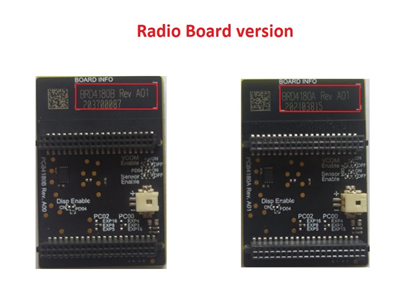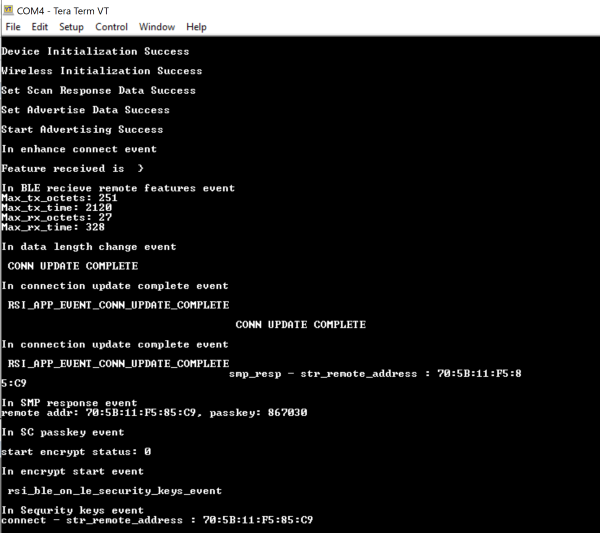BLE Privacy#
1. Purpose / Scope#
Bluetooth LE supports a feature that reduces the ability to track an LE device over a period of time by changing the Bluetooth device address on a frequent basis, called Privacy of that particular device.
The device address of the remote device referred to as the private address will be resolved by local device in order to connect to that device. The private address is generated by using Identity Resolving Key (IRK) exchange in between devices during SMP bonding procedure. Our local device will add the remote devices in one Resolving list(to maintain remote device identity addresses) along with that IRK's and enable the Resolution, sets privacy mode and connect to the remote device with remote identity address.
2. Prerequisites / Setup Requirements#
Before running the application, the user will need the following things to setup.
2.1 Hardware Requirements#
Windows PC with Host interface(UART/ SPI/ SDIO).
Silicon Labs RS9116 Wi-Fi Evaluation Kit
Host MCU Eval Kit. This example has been tested with:
Silicon Labs WSTK + EFR32MG21
Silicon Labs WSTK + EFM32GG11
BTLE peripheral device which supports privacy feature(Generally phones with the nRF Connect application)


2.2 Software Requirements#
Embedded Development Environment
For STM32, use licensed Keil IDE
For Silicon Labs EFx32, use the latest version of Simplicity Studio
Download and install the Silicon Labs EFR Connect App in the android smart phones for testing the BLE applications. Users can also use their choice of BLE apps available in Android/iOS smart phones.
3. Application Build Environment#
3.1 Platform#
The Application can be built and executed on below Host platforms
3.2 Host Interface#
By default, the application is configured to use the SPI bus for interfacing between Host platforms(STM32F411 Nucleo / EFR32MG21) and the RS9116W EVK.
This application is also configured to use the SDIO bus for interfacing between Host platforms(EFM32GG11) and the RS9116W EVK.
3.3 Project Configuration#
The Application is provided with the project folder containing Keil and Simplicity Studio project files.
Keil Project
The Keil project is used to evaluate the application on STM32.
Project path:
<SDK>/examples/snippets/ble/ble_privacy/projects/ble_privacy-nucleo-f411re.uvprojx
Simplicity Studio
The Simplicity Studio project is used to evaluate the application on EFR32MG21.
Project path:
If the Radio Board is BRD4180A or BRD4181A, then access the path
<SDK>/examples/snippets/ble/ble_privacy/projects/ble_privacy-brd4180a-mg21.slsprojIf the Radio Board is BRD4180B or BRD4181B, then access the path
<SDK>/examples/snippets/ble/ble_privacy/projects/ble_privacy-brd4180b-mg21.slsprojUser can find the Radio Board version as given below


EFM32GG11 platform
The Simplicity Studio project is used to evaluate the application on EFM32GG11.
Project path:
<SDK>/examples/snippets/ble/ble_privacy/projects/ble_privacy-brd2204a-gg11.slsproj
3.4 Bare Metal/RTOS Support#
This application supports bare metal and RTOS environment. By default, the application project files (Keil and Simplicity Studio) are provided with bare metal configuration.
4. Application Configuration Parameters#
The application can be configured to suit your requirements and development environment. Read through the following sections and make any changes needed.
4.1 Open rsi_ble_privacy.c file and update/modify following macros:
4.1.1 User must update the below parameters
RSI_BLE_DEVICE_NAME refers the name of the Silicon Labs device to appear during scanning by remote devices.
#define RSI_BLE_DEVICE_NAME "SIMPLE_PRIVACY"RSI_DEVICE_ROLE refers the role of the Silicon Labs device.
#define RSI_DEVICE_ROLE RSI_SLAVENote: RSI_DEVICE_ROLE should be RSI_MASTER
RSI_BLE_DEV_ADDR_TYPE` refers the address type of the remote device.
#define RSI_BLE_REMOTE_ADDR_TYPE LE_PUBLIC_ADDRESSRSI_BLE_DEV_ADDR_1 refers remote device address which has to connect.
#define RSI_BLE_REMOTE_ADDR "00:23:A7:56:77:77"RSI_REMOTE_DEVICE_NAME refers the name of the Remote device to which Silicon Labs module initiate connection.
#define RSI_REMOTE_DEVICE_NAME "BLE_SIMPLE_PRIVACY"RSI_BLE_SMP_IO_CAPABILITY refers the IO capability of Silicon Labs device for SMP, RSI_BLE_SMP_PASSKEY is smp passkey key from Silicon Labs device
#define RSI_BLE_SMP_IO_CAPABILITY 0x00
#define RSI_BLE_SMP_PASSKEY 0Power save configuration
By default, The Application is configured without power save.
#define ENABLE_POWER_SAVE 0If user wants to run the application in power save, modify the below configuration.
#define ENABLE_POWER_SAVE 1 4.1.2 The desired parameters are provided below. User can also modify the parameters as per their needs and requirements.
Following are the non-configurable macros in the application.
Following are the event numbers for connection, Disconnection, and enhanced connection events.
#define RSI_APP_EVENT_ADV_REPORT 0x00
#define RSI_BLE_CONN_EVENT 0x01
#define RSI_BLE_DISCONN_EVENT 0x02
#define RSI_BLE_SMP_REQ_EVENT 0x03
#define RSI_BLE_SMP_RESP_EVENT 0x04
#define RSI_BLE_SMP_PASSKEY_EVENT 0x05
#define RSI_BLE_SMP_FAILED_EVENT 0x06
#define RSI_BLE_ENCRYPT_STARTED_EVENT 0x07
#define RSI_BLE_SMP_PASSKEY_DISPLAY_EVENT 0x08
#define RSI_BLE_SC_PASSKEY_EVENT 0x09
#define RSI_BLE_LTK_REQ_EVENT 0x0A
#define RSI_BLE_SECURITY_KEYS_EVENT 0x0B
#define RSI_BLE_ENHANCE_CONNECTED_EVENT 0x0CBT_GLOBAL_BUFF_LEN refers Number of bytes required by the application and the driver.
#define BT_GLOBAL_BUFF_LEN 15000RSI_BLE_SET_RESOLVABLE_PRIV_ADDR_TOUT refers resolution timeout , that is the length of time the Controller uses a Resolvable Private Address before a new resolvable private address is generated and starts being used.
#define RSI_BLE_SET_RESOLVABLE_PRIV_ADDR_TOUT 120Process type refers the operation to be performed on the resolving list. valid configurations for the process type are
#define RSI_BLE_ADD_TO_RESOLVE_LIST 1
#define RSI_BLE_REMOVE_FROM_RESOLVE_LIST 2
#define RSI_BLE_CLEAR_RESOLVE_LIST 3RSI_BLE_PRIVACY_MODE refers the privacy mode of local device
#define RSI_BLE_PRIVACY_MODE RSI_BLE_DEVICE_PRIVACY_MODERSI_BLE_RESOLVING_LIST_SIZE refers the resolving list size of Silicon Labs device.
#define RSI_BLE_RESOLVING_LIST_SIZE 54.2 Open rsi_ble_config.h file and update/modify following macros
RSI_BLE_DEV_ADDR_RESOLUTION_ENABLE refers address resolution is enable or not. It should be 1 to enable privacy feature.
#define RSI_BLE_DEV_ADDR_RESOLUTION_ENABLE 1RSI_BLE_ADV_DIR_ADDR_TYPE refers the address type of remote device which use while advertising.
#define RSI_BLE_ADV_DIR_ADDR_TYPE LE_PUBLIC_ADDRESSRSI_BLE_ADV_DIR_ADDR refers to which device the local device will advertise with private address, it should be one of the device in resolve list.
#define RSI_BLE_ADV_DIR_ADDR "00:15:83:6A:64:17"
#define RSI_BLE_PWR_INX 30
#define RSI_BLE_PWR_SAVE_OPTIONS BLE_DISABLE_DUTY_CYCLING Opermode command parameters
#define RSI_FEATURE_BIT_MAP FEAT_SECURITY_OPEN
#define RSI_TCP_IP_BYPASS RSI_DISABLE
#define RSI_TCP_IP_FEATURE_BIT_MAP TCP_IP_FEAT_DHCPV4_CLIENT
#define RSI_CUSTOM_FEATURE_BIT_MAP FEAT_CUSTOM_FEAT_EXTENTION_VALID
#define RSI_EXT_CUSTOM_FEATURE_BIT_MAP 0Note!
rsi_ble_config.h files are already set with desired configuration in respective example folders user need not change for each example.
5. Testing the Application#
User has to follow the below steps for the successful execution of the application.
5.1 Loading the RS9116W Firmware#
Refer Getting started with PC to load the firmware into RS9116W EVK. The firmware binary is located in <SDK>/firmware/
5.2 Building the Application on the Host Platform#
5.2.1 Using STM32#
Refer STM32 Getting Started
Open the project
<SDK>/examples/snippets/ble/ble_privacy/projects/ble_privacy-nucleo-f411re.uvprojxin Keil IDE.Build and Debug the project
Check for the RESET pin:
If RESET pin is connected from STM32 to RS9116W EVK, then user need not press the RESET button on RS9116W EVK before free run.
If RESET pin is not connected from STM32 to RS9116W EVK, then user need to press the RESET button on RS9116W EVK before free run.
Free run the project
Then continue the common steps from Section 5.3
5.2.2 Using EFx32#
Refer EFx32 Getting Started, for settin-up EFR & EFM host platforms
Import the EFR32/EFM32 project from
<SDK>/examples/snippets/ble/ble_privacy/projectsSelect the appropriate .slsproj as per Radio Board type mentioned in Section 3.3 for EFR32 board. (or)
Select the *.brd2204a-gg11.slsproj for EFM32GG11 board.
Compile and flash the project in to Host MCU
Debug the project
Check for the RESET pin:
If RESET pin is connected from EFx32 to RS9116W EVK, then user need not press the RESET button on RS9116W EVK before free run
If RESET pin is not connected from EFx32 to RS9116W EVK, then user need to press the RESET button on RS9116W EVK before free run
Free run the project
Then continue the common steps from Section 5.3
5.3 Common Steps#
After the program gets executed, Silicon Labs module will be in Scanning state.
Advertise remote device,
If Silicon Labs module get device with name configured RSI_BLE_LOCAL_NAME or bd address with address configured in RSI_BLE_REMOTE_ADDR in results ,local device will try to connect with remote device.
After connection Silicon Labs device which is in central mode will initiate SMP request
Give response from Remote device and passkey
After successful SMP connection security keys will exchanged between Remote device and Silicon Labs device.
Silicon Labs device will add remote device's IRK's and local IRK's in to resolve list and enable resolution
Give disconnect from remote device and keep in advertise mode.
Now Silicon Labs module will try to connect to remote device with identity address.
After successful connection, Silicon Labs module will give start encryption instead of SMP repairing.
Encryption will be enabled on both sides.
After successful program execution, if Silcon Labs device connects to the remote BLE central device the prints in teraterm looks as shown below.




Find following screen shots for reference.
Advertise remote device


Connection in between Silicon Labs module and remote device


Pairing confirmation


Passkey confirmation


Compressed Debug Logging#
To enable the compressed debug logging feature please refer to Logging User Guide
